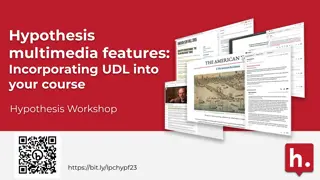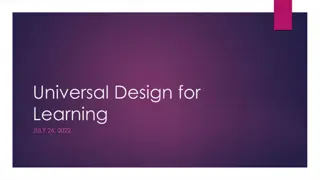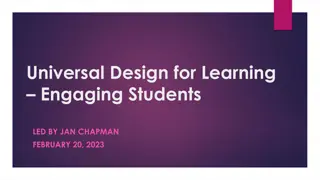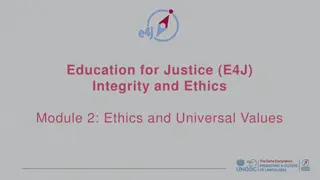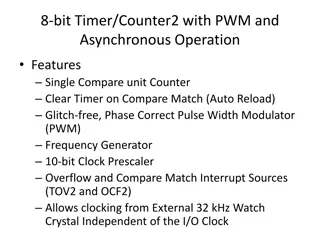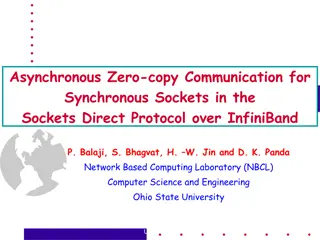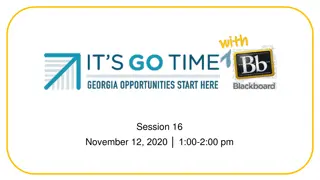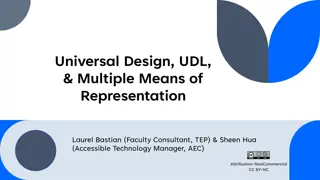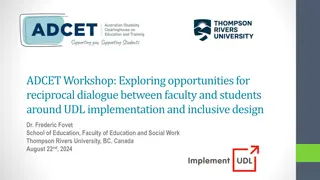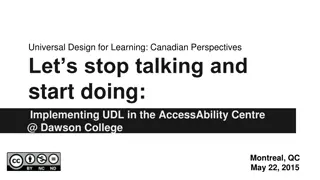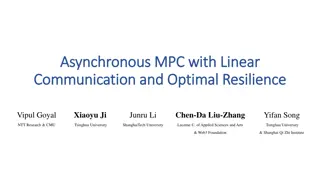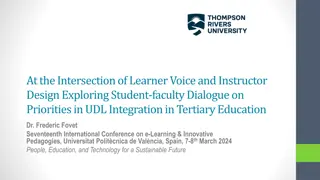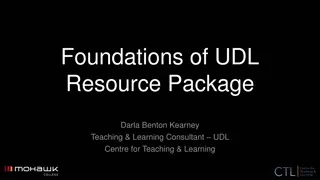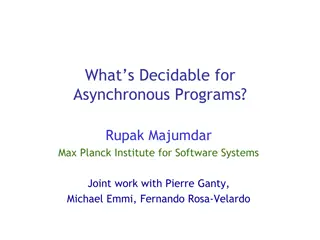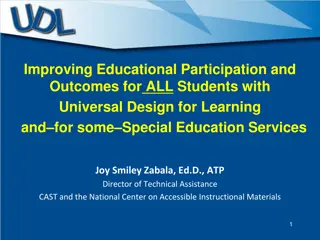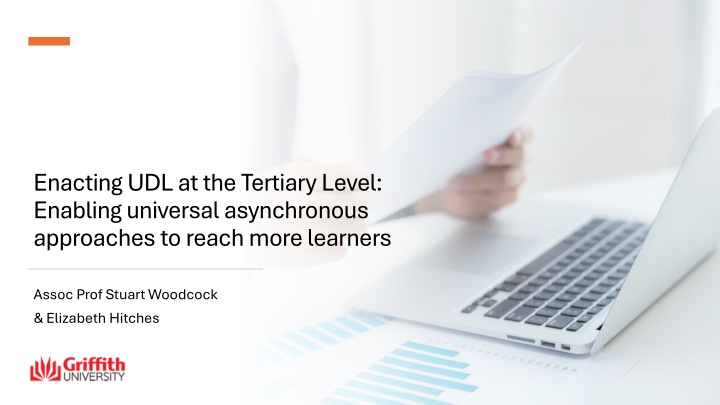
Enabling Universal Asynchronous Approaches for Tertiary Level Learners
"Discover how Universal Design for Learning (UDL) is utilized at the tertiary level to implement universal asynchronous approaches, ensuring inclusivity and engagement for diverse learners. Explore course overviews and modes that prioritize equitable access, participation, and engagement in higher education."
Download Presentation

Please find below an Image/Link to download the presentation.
The content on the website is provided AS IS for your information and personal use only. It may not be sold, licensed, or shared on other websites without obtaining consent from the author. If you encounter any issues during the download, it is possible that the publisher has removed the file from their server.
You are allowed to download the files provided on this website for personal or commercial use, subject to the condition that they are used lawfully. All files are the property of their respective owners.
The content on the website is provided AS IS for your information and personal use only. It may not be sold, licensed, or shared on other websites without obtaining consent from the author.
E N D
Presentation Transcript
Enacting UDL at the Tertiary Level: Enabling universal asynchronous approaches to reach more learners Assoc Prof Stuart Woodcock & Elizabeth Hitches
Acknowledgement of country We acknowledge the Traditional Custodians of the various lands on which we join from today and recognise their valuable contributions to Australian and global society. We pay our respects to their Elders, Ancestors and their descendants, who continue cultural and spiritual connections to Country. We acknowledge Aboriginal and Torres Strait Islander people participating in this event. We are joining from the lands of the Jageraand Turrbal peoples.
Housekeeping This session is being recorded. If you do not wish to appear on screen please hide camera. This session will be captioned. Session etiquette Session etiquette Please feel free to use the Chat Submit questions via theQ+A function Ensure your surrounding environment is quiet when mic is on (e.g., phones, pets etc). Turn off mic when not speaking. Chat for discussion. Q+A function or use the Raised hand Raised hand emoji during question time.
UDL at Tertiary Level Course Overview: Course: Inclusive Classrooms. Pre-service teachers (primary/secondary). Approx 400 students across three university campuses & online.
Overview of the course modes: Student Voices Inclusiveness Inclusiveness Modes available: Modes available: Weekly face-to face Weekly online (day/night) Intensive days (face-to-face) Recorded classes Recorded classes Regardless of the mode, students Regardless of the mode, students should: should: feel welcomed, valued, and considered. have equitable access and participation to learning. be actively engaged= motivation/persistence/autonomy. Observed benefits: Observed benefits: Learning: Learning: options for perception,action and expression, and engagement. Personal circumstances: Personal circumstances: enable equitable learning for a diversity of experiences (e.g., health, finances, carer responsibilities).
'Typical'recorded classes Recordings implemented as a 'back up Recordings implemented as a 'back up Misconceptions: Misconceptions: Live-time classes are a pedagogical preference. Attendance to live classes can often be compulsory. Recorded classes should not be relied upon. They are not engaging. They do not allow students to demonstrate understanding. They are only a 'quick fix' approach. Result: Result: non-inclusive recording. o Recording is clearly centred on students in the live class. o Miss out on 'learning' activities. o Recordings only capture part of the learning experience.
Who might depend on the recordings? 'Life throws an unexpected curve ball' 'Take in information at your own pace' 'Travel a lot' 'I work all day' Examples from students: Examples from students: 'Pregnant and have a lot of appointments' 'Professional Experience'
First iteration of a more universal inclusive approach (1) How might we provide equitable ways for students accessing and engaging classes, and also show them they areconsidered and valued considered and valued (and are not just onlookers!)? accessing and engaging in the recorded Welcome students joining live and watching the recording. While students engaging synchronously get settled into breakout rooms, address students watching the recording directly. Provide instruction on how they can engage in the learning activity independently and meaningfully (asynchronously). UDL: 7.3 Minimise threats (foster an accepting, supportive environment), 7.2 Optimise relevance
First iteration of a more universal inclusive approach (2) How might we provide equitable access to the co equitable access to the co- -constructed knowledge the class, and foster a sense of belonging in a learning sense of belonging in a learning community constructed knowledge which develops during community? Provide the links to shared working documents on the slides and in the recordedchat. After breakout group discussions, ensure groups summarise their learning for the whole class, meaning those watching the recording have access to these shared insights and feel part of the learning community. UDL: 1.2 offer alternatives to auditoryinformation,1.3 offer alternatives to visualinformation,8.3 Foster collaborationand community
First iteration findings: Students voices Benefits for personal circumstances: Benefits for personal circumstances: Accessibility (can access at a time and place that suits). Stress reducing (knowing there is a backup when the unexpected happens). Benefits for learning: Benefits for learning: Pace(own pace giving additional processing time; pause and rewind). Depthof understanding (revisionto build understanding).
What needed strengthening? How can students truly be part of that co construction construction of knowledge? co- - How can we build in opportunities for formative feedback feedback? formative How can students give/imply feedback to us? UDL: 8.3 foster collaboration and community, 8.4 increase mastery-orientated feedback
Strengthening this in the second iteration Use additional slides (while the live class is in break out rooms) specifically for asynchronous students to participate in an engaging activity online. Asynchronousstudents will access a shared document (throughout the course) to engage with this. Engagement is fostered in two ways: Part one Students engage with the week's activities Part two - The instructor will asynchronously join in the discussion from students' input into the activities answer any questions that students had for each activity as well as at the end of the session; an equivalent Q&A opportunity.
Concluding remarks Current Goal Current Goal how can we provide equitable and inclusive learning for those currently missing out? Students voices Students voices how can we draw on students' perspectives to strengthen inclusion and quality learning? Future Goal Future Goal how can this be provided as another valid learning option alongside other modes? Reminder Reminder students are illustrating the benefits of various options for learning modes (e.g., a/synchronous)
Contact us Stuart Woodcock Stuart Woodcock Griffith University s.woodcock@griffith.edu.au Elizabeth Hitches Elizabeth Hitches Griffith University e.hitches@griffith.edu.au

